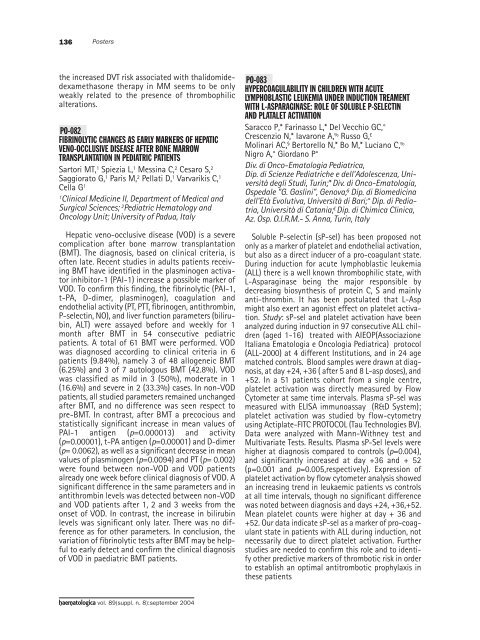Haematologica 2004;89: supplement no. 8 - Supplements ...
Haematologica 2004;89: supplement no. 8 - Supplements ...
Haematologica 2004;89: supplement no. 8 - Supplements ...
- No tags were found...
You also want an ePaper? Increase the reach of your titles
YUMPU automatically turns print PDFs into web optimized ePapers that Google loves.
136Postersthe increased DVT risk associated with thalidomidedexamethasonetherapy in MM seems to be onlyweakly related to the presence of thrombophilicalterations.PO-082FIBRINOLYTIC CHANGES AS EARLY MARKERS OF HEPATICVENO-OCCLUSIVE DISEASE AFTER BONE MARROWTRANSPLANTATION IN PEDIATRIC PATIENTSSartori MT, 1 Spiezia L, 1 Messina C, 2 Cesaro S, 2Saggiorato G, 1 Paris M, 2 Pellati D, 1 Varvarikis C, 1Cella G 11Clinical Medicine II, Department of Medical andSurgical Sciences; 2 Pediatric Hematology andOncology Unit; University of Padua, ItalyHepatic ve<strong>no</strong>-occlusive disease (VOD) is a severecomplication after bone marrow transplantation(BMT). The diag<strong>no</strong>sis, based on clinical criteria, isoften late. Recent studies in adults patients receivingBMT have identified in the plasmi<strong>no</strong>gen activatorinhibitor-1 (PAI-1) increase a possible marker ofVOD. To confirm this finding, the fibri<strong>no</strong>lytic (PAI-1,t-PA, D-dimer, plasmi<strong>no</strong>gen), coagulation andendothelial activity (PT, PTT, fibri<strong>no</strong>gen, antithrombin,P-selectin, NO), and liver function parameters (bilirubin,ALT) were assayed before and weekly for 1month after BMT in 54 consecutive pediatricpatients. A total of 61 BMT were performed. VODwas diag<strong>no</strong>sed according to clinical criteria in 6patients (9.84%), namely 3 of 48 allogeneic BMT(6.25%) and 3 of 7 autologous BMT (42.8%). VODwas classified as mild in 3 (50%), moderate in 1(16.6%) and severe in 2 (33.3%) cases. In <strong>no</strong>n-VODpatients, all studied parameters remained unchangedafter BMT, and <strong>no</strong> difference was seen respect topre-BMT. In contrast, after BMT a precocious andstatistically significant increase in mean values ofPAI-1 antigen (p=0.000013) and activity(p=0.00001), t-PA antigen (p=0.00001) and D-dimer(p= 0.0062), as well as a significant decrease in meanvalues of plasmi<strong>no</strong>gen (p=0.0094) and PT (p= 0.002)were found between <strong>no</strong>n-VOD and VOD patientsalready one week before clinical diag<strong>no</strong>sis of VOD. Asignificant difference in the same parameters and inantithrombin levels was detected between <strong>no</strong>n-VODand VOD patients after 1, 2 and 3 weeks from theonset of VOD. In contrast, the increase in bilirubinlevels was significant only later. There was <strong>no</strong> differenceas for other parameters. In conclusion, thevariation of fibri<strong>no</strong>lytic tests after BMT may be helpfulto early detect and confirm the clinical diag<strong>no</strong>sisof VOD in paediatric BMT patients.PO-083HYPERCOAGULABILITY IN CHILDREN WITH ACUTELYMPHOBLASTIC LEUKEMIA UNDER INDUCTION TREAMENTWITH L-ASPARAGINASE: ROLE OF SOLUBLE P-SELECTINAND PLATALET ACTIVATIONSaracco P,* Farinasso L,* Del Vecchio GC,°Crescenzio N,* Iavarone A, % Russo G, £Molinari AC, § Bertorello N,* Bo M,* Lucia<strong>no</strong> C, %Nigro A,° Giorda<strong>no</strong> P°Div. di Onco-Ematologia Pediatrica,Dip. di Scienze Pediatriche e dell'Adolescenza, Universitàdegli Studi, Turin;* Div. di Onco-Ematologia,Ospedale "G. Gaslini", Ge<strong>no</strong>va; § Dip. di Biomedicinadell'Età Evolutiva, Università di Bari;° Dip. di Pediatria,Università di Catania; £ Dip. di Chimica Clinica,Az. Osp. O.I.R.M.- S. Anna, Turin, ItalySoluble P-selectin (sP-sel) has been proposed <strong>no</strong>tonly as a marker of platelet and endothelial activation,but also as a direct inducer of a pro-coagulant state.During induction for acute lymphoblastic leukemia(ALL) there is a well k<strong>no</strong>wn thrombophilic state, withL-Asparaginase being the major responsible bydecreasing biosynthesis of protein C, S and mainlyanti-thrombin. It has been postulated that L-Aspmight also exert an agonist effect on platelet activation.Study: sP-sel and platelet activation have beenanalyzed during induction in 97 consecutive ALL children(aged 1-16) treated with AIEOP(AssociazioneItaliana Ematologia e Oncologia Pediatrica) protocol(ALL-2000) at 4 different Institutions, and in 24 agematched controls. Blood samples were drawn at diag<strong>no</strong>sis,at day +24, +36 ( after 5 and 8 L-asp doses), and+52. In a 51 patients cohort from a single centre,platelet activation was directly measured by FlowCytometer at same time intervals. Plasma sP-sel wasmeasured with ELISA immu<strong>no</strong>assay (R&D System);platelet activation was studied by flow-cytometryusing Actiplate-FITC PROTOCOL (Tau Tech<strong>no</strong>logies BV).Data were analyzed with Mann-Withney test andMultivariate Tests. Results. Plasma sP-Sel levels werehigher at diag<strong>no</strong>sis compared to controls (p=0.004),and significantly increased at day +36 and + 52(p=0.001 and p=0.005,respectively). Expression ofplatelet activation by flow cytometer analysis showedan increasing trend in leukaemic patients vs controlsat all time intervals, though <strong>no</strong> significant differencewas <strong>no</strong>ted between diag<strong>no</strong>sis and days +24, +36,+52.Mean platelet counts were higher at day + 36 and+52. Our data indicate sP-sel as a marker of pro-coagulantstate in patients with ALL during induction, <strong>no</strong>tnecessarily due to direct platelet activation. Furtherstudies are needed to confirm this role and to identifyother predictive markers of thrombotic risk in orderto establish an optimal antitrombotic prophylaxis inthese patientshaematologica vol. <strong>89</strong>(suppl. n. 8):september <strong>2004</strong>
















